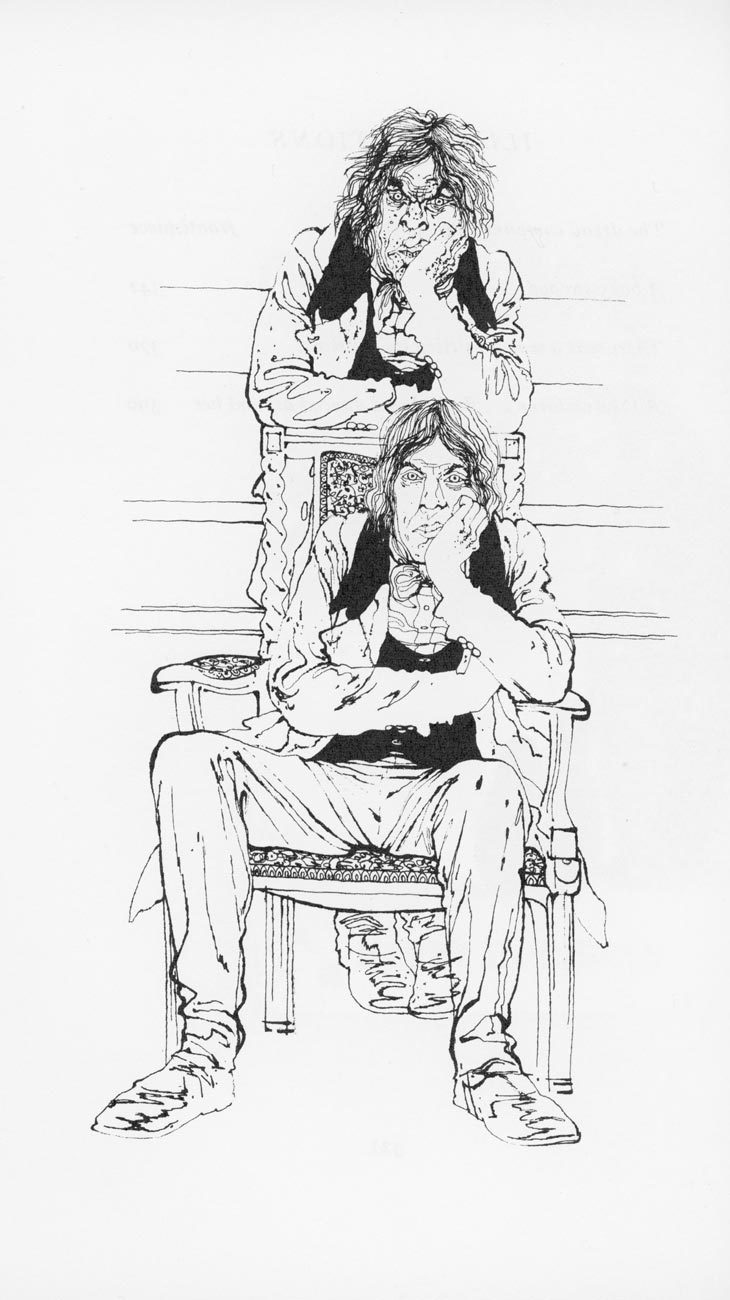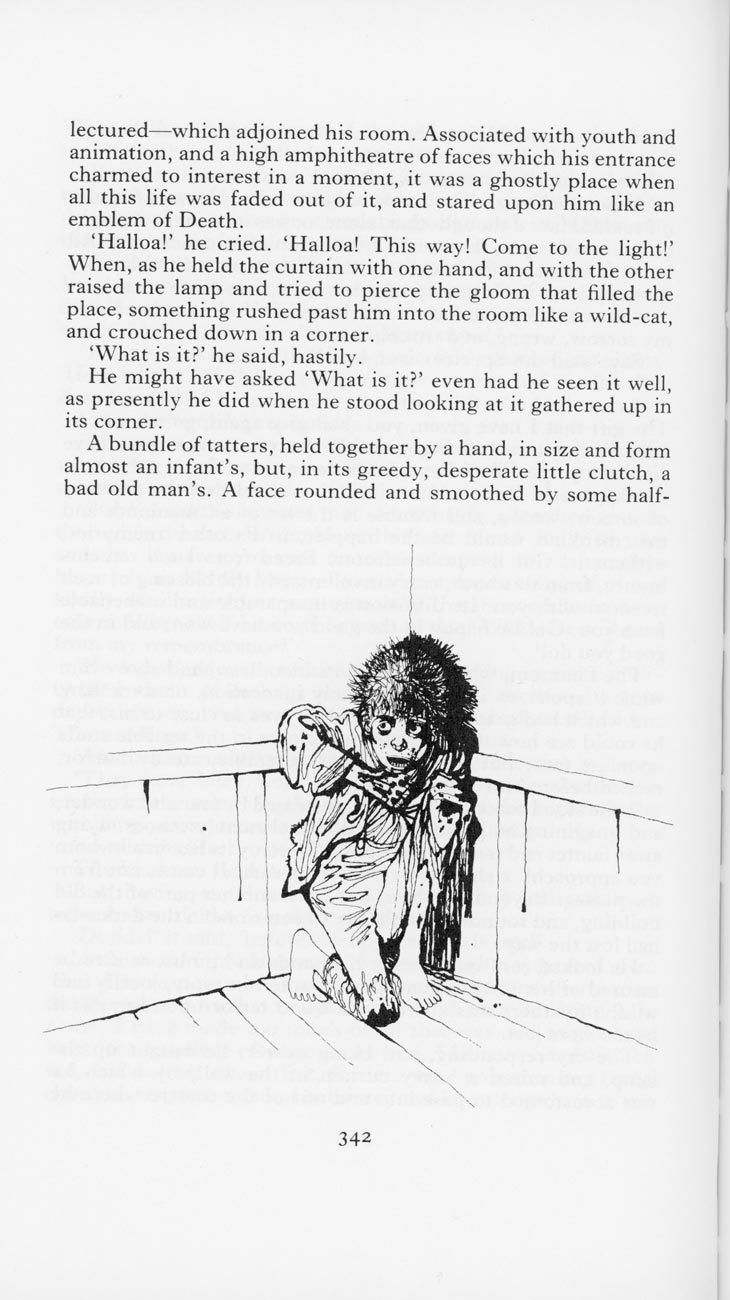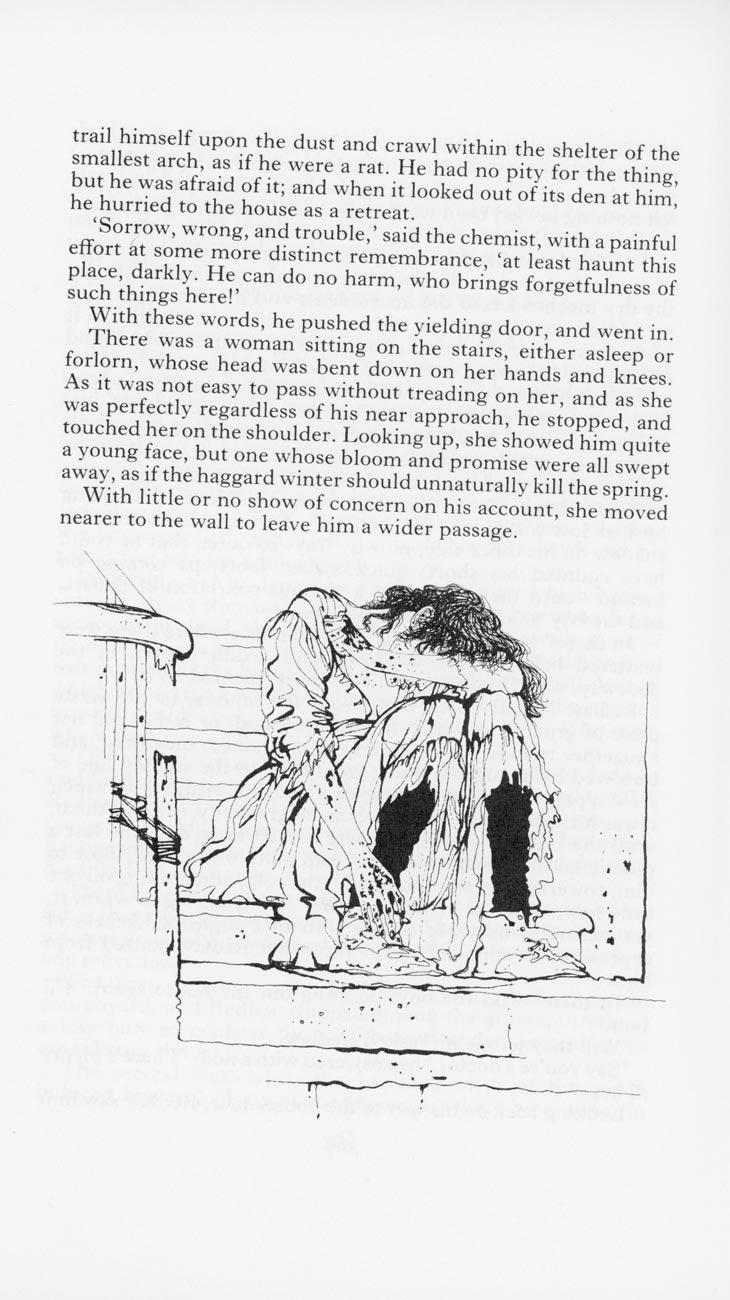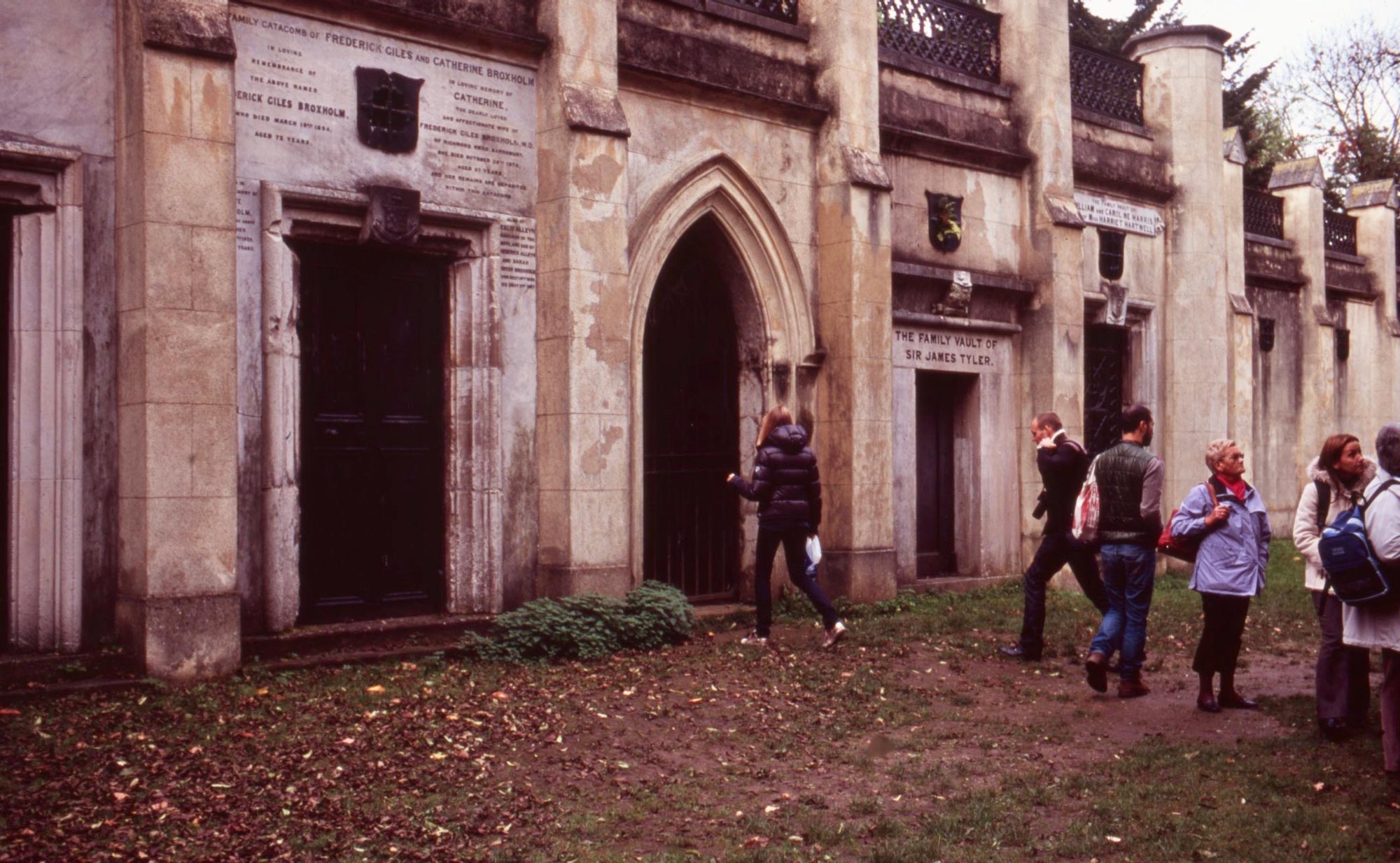



Yesterday I finished reading the fifth and final of Charles Dickens’s Christmas Books. This morning I scanned Charles Keeping’s faithful, first-class, illustrations.
Christopher Hibbert, in his informative introduction to my Folio Society edition, offers the insight that this work reflects painful experiences of the writer’s own life. Seeking freedom from his phantoms ‘The Haunted Man’ of the novella appeals for forgetfulness. The story reveals that forgiveness is really what is required. Once more this tale has been overshadowed by ‘A Christmas Carol’. It does, however contain much of Dickens’s splendid descriptive writing laced with his wry humour.
Highgate West Cemetery, in September 2008, when I produced the batch of colour slides scanned this afternoon, was nowhere near as oppressively gloomy as the heavy atmosphere that prevailed outside my workroom window.

John Turpin, who wrote the text for ‘The Magnificent Seven’, and I needed to join the above paying group to visit this fine example of London’s Victorian landscaped burial grounds. Although wealthy enough to have afforded these final resting places, I have gleaned no information about the various residents.


Steps lead down to these lower levels which also house the columbarium, from the Latin for pigeon-house, which contains niches for storing funeral urns.
I do not know who warranted this elaborate marker.



These three are memorable for their animals. His mastiff guards the remains of Thomas Sayers.
This is what Wikipedia tells us about him: ‘Tom Sayers (15 or 25 May[1] 1826 – 8 November 1865) was an English bare-knuckle prize fighter. There were no formal weight divisions at the time, and although Sayers was only five feet eight inches tall and never weighed much more than 150 pounds, he frequently fought much bigger men. In a career which lasted from 1849 until 1860, he lost only one of sixteen bouts. He was recognized as heavyweight champion of England between 1857, when he defeated William Perry (the “Tipton Slasher”) and his retirement in 1860.
His lasting fame depended exclusively on his final contest, when he faced American champion John Camel Heenan[2] in a battle which was widely considered to be boxing’s first world championship. It ended in chaos when the spectators invaded the ring, and the referee finally declared a draw.
Regarded as a national hero, Sayers, for whom the considerable sum of £3,000 was raised by public subscription, then retired from the ring. After his death five years later at the age of 39, a huge crowd watched his cortège on its journey to London’s Highgate Cemetery.’ His origins are also related in https://en.wikipedia.org/wiki/Tom_Sayers
John Atcheler, commemorated by a horse on a plinth, was reputedly horse-slaughterer to Queen Victoria. Maybe someone was indulging a wry sense of humour.
Menageries were popular in Regency and early Victorian England. The lion resting above the remains of George Wombwell represents a favourite exhibit of that individual who, according to Wikipedia
‘was born in Wendon Lofts, Essex in 1777. Around 1800 he moved to London and in 1804 became a shoemaker in Soho. However, when a ship from South America brought two boas to London docks, he bought them for £75 and began to exhibit them in taverns. He soon made a good profit.
Wombwell began to buy exotic animals from ships that came from Africa, Australia and South America, and collected a whole menagerie and put them on display in Soho. In 1810 he founded the Wombwell’s Travelling Menagerie and began to tour the fairs of Britain. By 1839 it totalled fifteen wagons, and was accompanied by a brass band.
His travelling menagerie included elephants, giraffes, a gorilla, a hyena, kangaroo, leopards, 6 lions, llamas, monkeys, ocelots, onagers, ostriches, panthers, a rhino (“the real unicorn of scripture”), 3 tigers, wildcats and zebras. However, because many of the animals were from hotter climes, many of them died in the British climate. Sometimes Wombwell could profitably sell the body to a taxidermist or a medical school, other times he chose to exhibit the dead animal as a curiosity.
Wombwell bred and raised many animals himself, including the first lion to be bred in captivity in Britain; he named it William in honour of William Wallace. In 1825 Warwick, Wombwell, in collaboration with Sam Wedgbury and dog dealer Ben White’s assistant Bill George,[1]arranged a Lion-baiting between his docile lion Nero and six bulldogs. Nero refused to fight but when Wombwell released Wiliam, he mauled the dogs and the fight was soon stopped.
Over the years, Wombwell expanded three menageries that traveled around the country. Wombwell was a regular exhibitor at the annual Knott Mill Fair in Manchester, a venue he sometimes shared with Pablo Fanque‘s circus.[2][3] He was invited to the royal court on five occasions to exhibit his animals, three times before Queen Victoria. In 1847 the Queen Victoria noted the bravery of the “British Lion Queen”, the nickname of Ellen Chapmanwho appeared with lions, leopards and tigers. Chapman married Wombwell’s business rival George Sanger in 1850.[4]
On one occasion Prince Albert summoned him to look at his dogs who kept dying and Wombwell quickly noticed that their water was poisoning them. When the prince asked what he could do in return for this favour, Wombwell said, “What can you give a man who has everything?” However, Wombwell requested some oak timber from the recently salvaged Royal George. From this he had a coffin fashioned for himself, which he then proceeded to exhibit for a special fee.
Wombwell frequented Bartholomew Fair in London and even developed a rivalry with another exhibitor, Atkins. Once when he arrived at the fair, his elephant died and Atkins put up a sign “The Only Live Elephant in the Fair”. Wombwell simply put up a scroll with the words “The Only Dead Elephant in the Fair” and explained that seeing a dead elephant was an even a rarer thing than a live one. The public, realising that they could see a living elephant at any time, flocked to see and poke the dead one. Throughout the fair Atkins’ menagerie was largely deserted, much to his disgust.
George Wombwell died in 1850 and was buried in his Royal George coffin in Highgate Cemetery, under a statue of his lion Nero.
The book George Wombwell (1777 – 1850): Volume One recalls the lion and dog fight in Warwick with well researched evidence, but questions whether it ever actually took place. George Wombwell (1777 – 1850): Volume Two covers Wombwell’s life as the most famous showman, from his arrival in London around 1800 to his death in 1850.[5]
In 1851 a tapir broke out of its den at Wombwell’s Menagerie in Rochdale, causing panic among the spectators.[6]



The cedar of Lebanon in the second and third of these pictures is one of the cemetery’s original plantings.
This evening we dined on Jackie’s substantial, wholesome, chicken and vegetable stoup and crusty bread with which she drank Hoegaarden and I drank more of the Fleurie.

I was surprised by how overgrown everything seems. Is that by choice or circumstance? It’s actually rather appealing. I could spend a happy day there prowling among the burial sites.
These cemeteries are mostly managed by volunteers and cash-strapped local authorities. Highgate has a Society of Friends. So it is circumstances really, Linda. Thanks very much.
I was wondering the same thing. Mount Auburn Cemetary in Cambridge, Massachusetts is also a garden cemetary, and the majority of it is manicured. I get the sense from their website that there are multiple sources of revenue that contribute to the cost of upkeep.
Is the Angel, pictured in your 2013 postscript to your original Magnificent Seven post, from West Norwood cemetery, Derrick? It’s very beautiful and I’m sure I recognise it!
I think it might be, Emma. I’ll double check when I work on those slides. Thanks very much
I think I have probably observed before that much older graves reveal much about the society of the time. I enjoy visiting old cemeteries, especially in rural towns, when I can.
Yes, indeed, Anne. Thank you very much
As always with stories like this, my thoughts turn to the poor creatures.
Indeed. Laurie. Thank you very much
The drawings by Charles Keeping are superbly first-class, illustrations. Derrick.. Thank you for these photo scans..
And thank you for your appreciation, Ivor
Such expressive illustrations for the Dickens’s story.
And thank you for the photos and history of monuments in the cemetery. The lion looks gentle and thoughtful.
And thank you very much, Merril. The sculptor has caught the nature of Nero
The illustrations are fascinating.
Thanks very much, Cindy
I enjoyed all of the interesting markers.
Thanks very much, Jill
Ik ben opnieuw geabonneerd op uw blog. Ik ging de mist weer in en ik u zoeken, maakte me ongerust en dacht: Jezus! Het zal toch niet … Verdomme! Blijf gezond samen met Jakie … Jeetje! Ik schreef: “Waarom eten jullie geen appelflappen met heel, veel poedersuiker bij de Engelse thee? Ik kom wel effe …” En toen schrokken jullie je driedubbel hartstikke dood … , of niet?
Appelflappen eet je met oud & nieuwjaar in Holland en als ik dan toch zelf iets bak: drie in de pan met rozijnen en krenten. Ik kan géén appelflappen frituren, dat heb ik niet in de keuken en ik hoef die vette bende ook niet.
Hendrikje de Brave nam drie oliebollen mee en die aten we samen op: meer dan genoeg!
Gesodemieter! In januari moeten alle extra pondjes er weer vanaf … Gelazer in de glazen! Elfriede, heel veel liefs voor 2021, met heel veel rozen in de tuin! * Amsterdam, 10 januari 2021 * http://www.friedabblog.wordpress.com *
Heel erg bedankt, Frieda. Uw goede wensen beantwoord
Ik ben druk bezig voor de ‘www.Stichting Amsterdamse Zwerfkatten.nl’, http://www.poezenboot.nl, http://www.asielopvang.nl, om me oude spullen, zoals kleren, schoenen, boeken en van alles te doneren en het geld dat zij ermee verdienen is voor de hongerige katten. In deze lockdown’s hebben de dieren het ook moeilijk in Artis en overal in alle dierentuinen.
Ik zag op tv. dat ze twee honden in het asiel lieten inslapen, omdat het te duur werd … Het waren prachtige en gezonde honden: pittig en vol leven … , gangmakers, drukte makers en een beetje agressieve honden, wat heel normaal is … Die verzorgster huilde … , iedereen vond het verschrikkelijk …
Werd overal over gezeken in alle ‘Tolkshow’s’ op tv: Ze raakte er niet over uit gepraat en dan zeg ik vaak: Doe iets! Ga desnoods als vrijwilligster met die honden wandelen … Geouwehoer, daar kopen we niks voor!
Elfriede * http://www.friedabblog.wordpress.com * Amsterdam, 11 – 1- 2021 * Heel, veel liefs uit Holland!
“A Prizefighter, A Knacker, And A Menagerist”, that sounds like the good beginning for one of those ‘walked into a bar’ jokes!
When I read the title, I thought of the same thing!
Sisters with different mothers? <3
And great minds think alike! <3
<3
I’m so pleased that wasn’t wasted
It wasn’t alliteration, but very satisfying nevertheless.
The graves with animals above and ivy and ferns below look peaceful. I like the natural landscaping.
Thank you very much, JoAnna
Marvelous, very complex illustrations; thank you for sharing them, Derrick. Thank you also for the black and whites. Fascinating story of Wombwell and his menagerie.
My thanks to you as well, Dolly, for your appreciation. You’ll be pleased to know I haven’t gone off piste yet as I have just started on ‘Hard Times’
Ah, so you are going through the entire Dickens. You are very welcome, Derrick.
So far
Derrick, thank you for the glimpse of life in another time through the stories of the dead. I feel for the animals in that menagerie, though people had different sensibilities back then.
Indeed, Lavinia. Wild animals were mere objects of curiosity. Thank you for your appreciation of the post.
Mr. Keeping’s artwork is so expressive, so detailed, and interesting to peruse!



I always feel a reverence in your cemetery photos. Those animal sculptures are so wonderful.
(((HUGS)))
PS…Much better a wholesome chicken than an unwholesome one!
Thanks very much, Carolyn X
A fascinating post, Derrick, thank you. The details about George WombwelI were wonderful, and I particularly enjoyed the link to Pablo Fanque who I had always thought was just a made up person.
Thanks very much, John.
Charles Keeping’s illustrations look incredible! The markers look quite intriguing.
Thanks very much, D. Keeping produced some wonderful children’s books, most of which I gave to a granddaughter.
The information about Highgate Cemetary and some of the people buried there is fascinating. Wombell sounds like a very enterprising fellow, along the lines of a P.T. Barnum.
I think there were a number of them in those days. Thanks very much, Liz
You’re welcome, Derrick.
interesting and fascinating stories, Derrick. a peaceful almost undisturbed resting place.
Thanks very much, Lola
Hi Derrick
This was a fantastic read with some tea just now !
Oh thanks amigo
And top takeaway was Wombwell and his story – quite the animal whisperer – entrepreneur and even maybe biologist !
Thanks very much, Yvette. I’m pleased you liked it.
Loved it –
Another one of your cemetery series with interesting detail. The ‘Columbarium’ bears a grim look now. The Cedar of Lebanon has witnessed a lot under the English sun.
Thank you very much for your close reading and consequent comments, Uma.
Those animals are wonderful! And what a history!
Thanks very much, Ribana
Another fascinating funereal post. The dead do tell tales.
Thanks very much, Lindsey
Fascinating information Derrick, particularly the story behind Tom Sayers. My father, along with his brother was a prize fighter in Ireland during the 1920’s so I find that very interesting.
Equally fascinating, John. Thanks very much